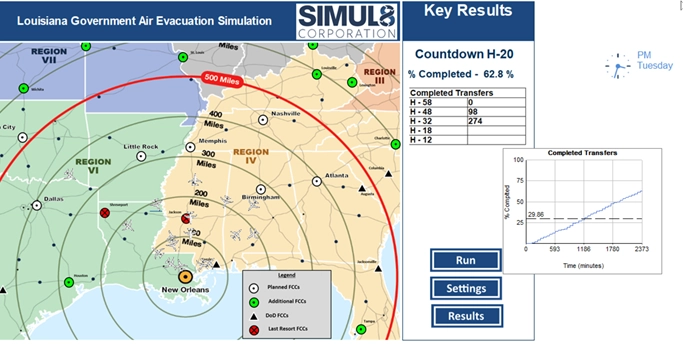Louisiana Department of Health improves emergency evacuation planning

- Industry
- Healthcare
- Location
- Louisiana, U.S.
- Goals
- Test the robustness of hospital air evacuation plans
Achievements with Simul8
-
-
Saved over 80 hours of work over a spreadsheet-based approach
About the project
Planning for large-scale hospital evacuations in the event of destructive hurricanes and tropical storms is a year-round effort for the Louisiana Department of Health (DOH). But with limited resources, the state does not have the surge capacity to absorb patients in hospitals outside of the typical storm risk area, or ambulance capacity to be able to safely transfer patients. As a result of these limitations, transferring patients from affected hospitals to facilities in neighboring states by air is the only viable solution.
The movement of patients out-of-state also involves coordination between several local, state and federal agencies, adding to the complexity of planning, both in terms of scale and process, for DOH’s emergency preparedness team.
In order to test the robustness of air evacuation plans, DOH staff needed emergency evacuation software to evaluate likely volumes of patients to be transferred and understand how many hours the entire process would take under a range of possible scenarios.
To improve the speed and precision of testing, DOH staff turned to Simul8's simulation software and consultant expertise. Simul8's emergency evacuation software enabled the team to incorporate all the complexities and variability of air evacuations in their analysis, as well as visualizing the process to enhance stakeholder communication and decision-making.


"Spreadsheet-based models of complex problems are too difficult to build. They are also challenging to present to stakeholders who have no knowledge of stochastic modeling. We needed a more visual and engaging approach.
"We evaluated a range of applications, including Visio-based modeling tools, but Simul8 came out on top because of its combination of value, features, support and the visualization aspect."
MSW, Emergency Preparedness Section, Louisiana Department of Health

The approach
DOH started the project by collecting likely volumes of patients that would require evacuation. Typically, larger facilities could weather the storm winds and surge of water, but the ability of some smaller facilities to survive the storm was more limited.
Using data from hospitals that had previously needed pre-storm assistance, as well as input from subject matter experts, DOH staff created a basic spreadsheet model with the following assumptions and results:
- A limited scenario with a range of 12 to 18 hospitals that may require evacuation
- A probabilistic range that DOH could be 95% certain that the number of patients requiring evacuation could range from 555 to 619 patients
- 54 medically configured jets would be available, accommodating only 1 patient per flight
- 2 or 3 debarkation airfields across approximately 150 miles
- A fleet of 50 ambulances per operating airfield for patient movement from hospital to airfield
- Up to 7 potential destination airports in 6 neighboring states
- Given the combinations of departing and arriving airfields, round trip times ranging from 1.5 hours to over 3 hours per flight (calculated using distributions for total miles 1-way, aircraft airspeed, time to load and unload patients, and time to refuel)
- A limitation of up to 5 active jets at any time for an airport - a factor known as Maximum on Ground (MOG)
Other critical considerations also had to be incorporated to be able to accurately simulate the process, but were difficult to model in a spreadsheet, included:
- Probability that a flight would occur - delays or cancellations could occur to aircraft breakdowns, flight crew availability
- The type of patient (critical or non-critical) and air-medical staff required
- The time required for maintenance of the aircraft
- The rate of flow of patients to the airfield, given different MOG factors for each airport and plane assignment


"I’d recommend Simul8 as it’s a reliable product and has been cost-effective to deploy. The consultant and support teams have given us fast, effective assistance with simulation model building and knowledge transfer.
They are hands-down the easiest company to work with in this space."
MSW, Emergency Preparedness Section, Louisiana Department of Health

The solution
Simul8's emergency evacuation simulation software was chosen by the team as its powerful features and intuitive interface enabled DOH staff to incorporate the complexity and variability involved in the air evacuation process.
Using flow charts of the process, key data points and distributions, Simul8's consultants collaborated closely with DOH staff to build a visual simulation model of the entire process from patient movement, to the airfield, to flights and destinations and aircraft returns.
The emergency evacuation simulation software incorporated all the key factors and variability of the process, including:
- The combinations of departing and arriving airfields
- The number of ‘take-off’ slots driven by the MOG factors at each airfield
- Number of patients requiring evacuation and their destination airfield
- The ambulance transportation from hospital to airfield
- The rate of patients arriving at each airfield
- Process times for patient loading and departure from the embarkation airfield, flight time, debarkation airfield unloading and re-fueling and return flight times
- A ‘breakdown’ factor was included along with probable maintenance times to return the plane to service
- Simulating this complex process within a 38-hour time window, showing countdowns
DOH staff were able to easily modify the initial distribution functions and data points as needed, incorporating data from the federal flight contractor on aircraft, flight times, airspeeds, crew requirements and more.
With the simulation's visuals, DOH staff were also able to demonstrate to stakeholders how the entire evacuation process would play out under a range of scenarios, with on screen charts showing the number of patients transferred in the allotted time period.
For example, the team could quickly create a scenario of 600 patients requiring evacuation from up to 12 hospitals, using 2 debarkation airfields. Flights could be modeled to the 7 receiving airports, based on the number of planes assigned to each debarkation airfield and capabilities of the receiving states.



“We have worked with a number of vendor consultants over the years, but Simul8 have emerged top in terms of time from scope development to delivery, cost, and availability. Their team gave us exactly what we needed first time.
They collaborated with us to build a simulation with an eye on the future, allowing us to easily expand the simulation without completely revising the structure. That is rare.”
MSW, Emergency Preparedness Section, Louisiana Department of Health

The outcome
Simulating the complex evacuation process using Simul8 delivered immediate benefits to DOH staff and its stakeholders. As well as showing the number of patients transferred by air with the timeline for movement, the simulation allowed the team to understand the impact of any changes to the process on the total time taken.
The simulation also helped change stakeholders' mindset from planning focused on definitive numbers to considering the impact of uncertainty and variability, ensuring more robust planning across a range of scenarios.
"The simulation clearly changed the expectation of ‘give us a number’ to ‘wow, we can incorporate uncertainty.’ This was perhaps the most valuable benefit for us”, says Henry Yennie of DOH's Emergency Preparedness Section.
He adds that this outcome would have been much more difficult to reach had a spreadsheet-based approach been used: "I think a conservative estimate of time saved from using simulation is between 60 and 80 hours. I also believe we would not have been able to model all of the factors in the same fashion as we could in the Simul8 simulation."
The team intend to use the simulation to start planning for the 2019 hurricane season. As well as showing the simulation to local, state and federal agencies, DOH staff also want to use it to benefit hospital-level staff. "We want to bring the simulation to hospital level in the coming months so that our evacuating hospitals get to see the “big picture” and the effect of late decision-making.", adds Yennie.
Learn more about Simul8 for healthcare process improvement
Find out more about how simulation is used by healthcare organizations, read more case studies and access a range of learning resources.
Learn more